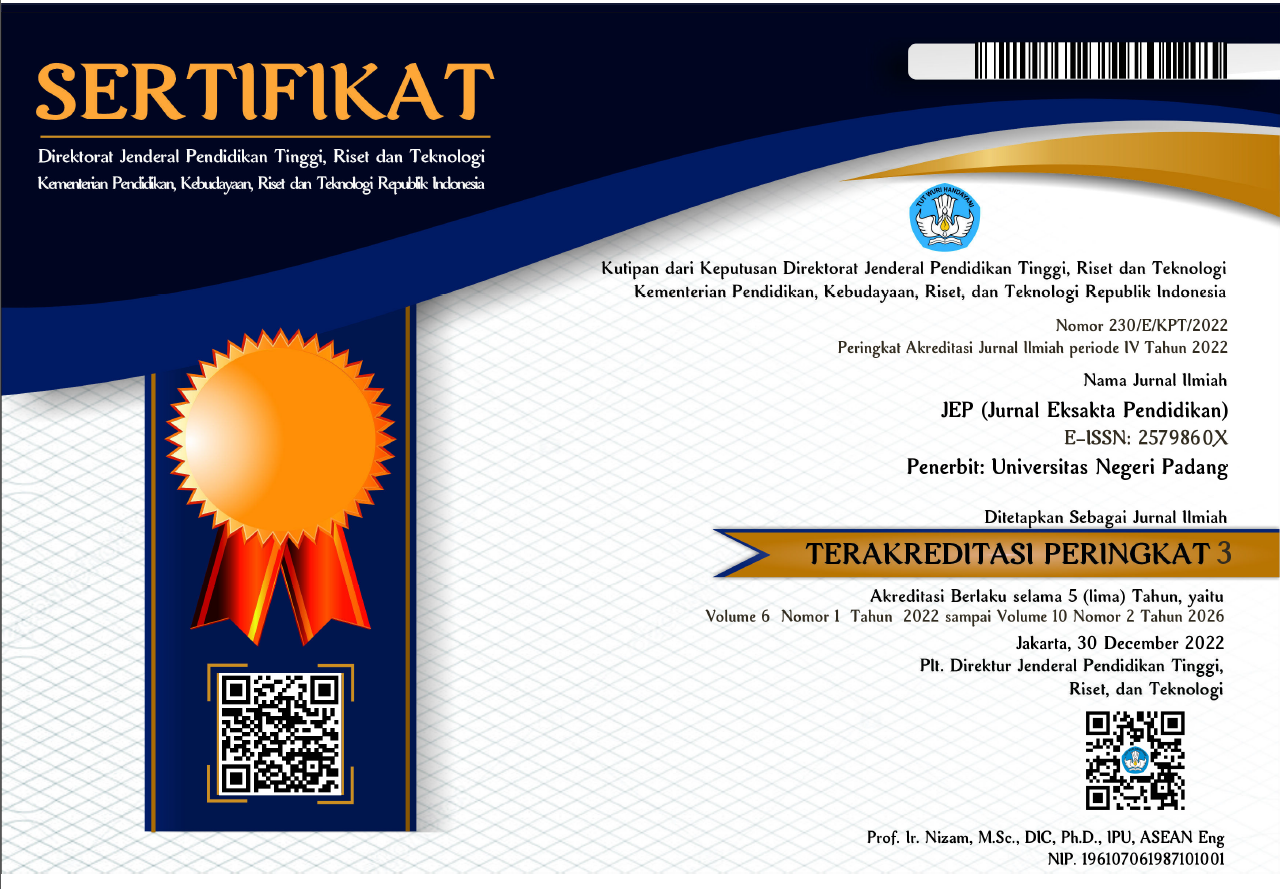Research Trends in The Development of Biology Learning Media in Indonesia: A Bibliometric Analysis
Abstract
Several bibliometric studies have been conducted to see the progress of Biology Learning Media (BLM), but these researches still provide a broad scope in evaluating the development of BLM. This study aims to provide a holistic overview of the trends in the use of BLM in Indonesia during 2018-2023 on the Scopus database. The method used is bibliometric analysis by identifying and analyzing the growth patterns of literature, authors, institutions, and keywords related to BLM development. The research procedure consisted of investigation, reduction, compilation, and interpretation. A total of 43 articles were analyzed using VOSviewer software to visualize bibliometric mapping. For the last five years, BLM-related publications peaked in 2019 with 13 articles. Universitas Negeri Malang is a foremost institution in BLM development. The most widely used BLM are android-based media, interactive multimedia, and website-based media. Ecology is the most widely taught learning topic, while cognitive (knowledge) is the most frequently measured learning outcome. We highlighted a paradigm change in the use of more massive Technology-based learning media. In the future, we suggest exploring various research topics in biology learning such as protists, genetics, or microbiology that can empower literacy as a primary topic in more innovative and dynamic learning.
Downloads
References
Anjani, M., & Yustim, B. (2019). Learning media for biology subject based on multimedia in junior high school level. Universal Journal of Educational Research, 7(4), 43–51. https://doi.org/10.13189/ujer.2019.071407
Arici, F., Yildirim, P., Caliklar, Ş., & Yilmaz, R. M. (2019). Research trends in the use of augmented reality in science education: Content and bibliometric mapping analysis. Computers and Education, 142(March), 103647. https://doi.org/10.1016/j.compedu.2019.103647
Astriawati, F. (2019). Developing Chamilo-Based E-Learning in Environmental Change Material to Enhance Students’ Scientific Literacy Skills. Journal of Physics: Conference Series. https://doi.org/10.1088/1742-6596/1397/1/012049
Badria, I. L., Ibrohim, I., & Suhadi, S. (2021). The implementation of problem-based learning model with the local potential resources in Kebundadap Timur-Sumenep district to improve science process skills and environmental attitudes of SMA students. In S. H., H. H., & R. D. (Eds.), AIP Conference Proceedings (Vol. 2330). American Institute of Physics Inc. https://doi.org/10.1063/5.0043412
Donthu, N., Kumar, S., Mukherjee, D., Pandey, N., & Lim, W. M. (2021). How to conduct a bibliometric analysis: An overview and guidelines. Journal of Business Research, 133(May), 285–296. https://doi.org/10.1016/j.jbusres.2021.04.070
Irwansyah, M., Ferawati, F., Suryani, E., Olahairullah, O., Ariyansyah, A., Nurfathurrahmah, N., & Rubianti, I. (2020). Developing biology learning tools based on character education integrated with sustainable local wisdom to enhance 21st-century attitude of students. Journal of Physics: Conference Series, 1521(4). https://doi.org/10.1088/1742-6596/1521/4/042017
Jacobson, M. J., & Archodidou, A. (2000). The Design of Hypermedia Tools for Learning: Fostering Conceptual Change and Transfer of Complex Scientific Knowledge. Journal of the Learning Sciences, 9(2), 145–199. https://doi.org/10.1207/s15327809jls0902_2
Kirkwood, A., & Price, L. (2014). Technology-enhanced learning and teaching in higher education: what is ‘enhanced’ and how do we know? A critical literature review. Learning, Media and Technology, 39(1), 6–36. https://doi.org/10.1080/17439884.2013.770404
Kusmahardhika, N., Mahanal, S., Balqis, B., & Gaffar, H. A. (2024). Cluster Analysis and Network Visualization of Biology Education Research in Indonesia : A Bibliometric Analysis. Prisma Sains : Jurnal Pengkajian Ilmu Dan Pembelajaran Matematika Dan IPA IKIP Mataram, 12(2), 285–295. https://doi.org/https://doi.org/10.33394/j-ps.v12i2.10574
Kusmahardhika, N., Prasetyo, T. I., & Wati, B. M. (2023). The Development of Learning Tools Based on STEM-PjBL to Increase Cognitive Learning Outcomes for 10th Grade Students. AIP Conference Proceedings, 2569, 112237. https://doi.org/10.1063/5.0112237
Lee, A. Y. L. (2016). Media education in the School 2.0 era: Teaching media literacy through laptop computers and iPads. Global Media and China, 1(4), 435–449. https://doi.org/10.1177/2059436416667129
Munyemana, J. J., Nsanganwimana, F., & Gaparayi, G. (2023). Trends in Use of the Computer Assisted Instruction in Biological Sciences Education: A Systematic Literature Review. International Journal of Information and Education Technology, 13(3), 551–557. https://doi.org/10.18178/ijiet.2023.13.3.1838
Murayama, K., FitzGibbon, L., & Sakaki, M. (2019). Process Account of Curiosity and Interest: A Reward-Learning Perspective. Educational Psychology Review, 31(4), 875–895. https://doi.org/10.1007/s10648-019-09499-9
Newman, J. (2024). Promoting Interdisciplinary Research Collaboration: A Systematic Review, a Critical Literature Review, and a Pathway Forward. Social Epistemology, 38(2), 135–151. https://doi.org/10.1080/02691728.2023.2172694
Oudeyer, P.-Y., Gottlieb, J., & Lopes, M. (2016). Chapter 11 - Intrinsic motivation, curiosity, and learning: Theory and applications in educational technologies. In B. Studer & S. B. T.-P. in B. R. Knecht (Eds.), Motivation (Vol. 229, pp. 257–284). Elsevier. https://doi.org/https://doi.org/10.1016/bs.pbr.2016.05.005
Perdana, I., Arifin, A., Hati, K., Subagiharti, H., & Handayani, D. S. (2023). Android-based learning media for learning styles and student learning outcomes. THE 2ND NATIONAL CONFERENCE ON MATHEMATICS EDUCATION (NACOME) 2021: Mathematical Proof as a Tool for Learning Mathematics, 2811, 120003. https://doi.org/10.1063/5.0115207
Prasetyo, T. I., Handayani, N., Zulfa, A. R., & Alifah, L. N. (2021). Development of learning tools based on pirposal model on respiratory and excretion systems materials. In S. H., H. H., & R. D. (Eds.), AIP Conference Proceedings (Vol. 2330). American Institute of Physics Inc. https://doi.org/10.1063/5.0043534
Puspa, V. R., Hidayat, T., & Supriatno, B. (2021). Development of android-based digital determination key application (e-KeyPlant) as learning media for plant identification. Journal of Physics: Conference Series, 1806(1). https://doi.org/10.1088/1742-6596/1806/1/012145
Ramdiah, S., Abidinsyah, A., Royani, M., Husamah, H., & Fauzi, A. (2020). South Kalimantan local wisdom-based biology learning model. European Journal of Educational Research, 9(2), 639–653. https://doi.org/10.12973/eu-jer.9.2.639
Sagita, S. G. N., & Aminatun, T. (2019). Combination of CPS and SAVI on Biology Learning Media to Improve Student’s Understanding and Creativity on Environmental Change Topic. In W. R., W. A., & T. K. (Eds.), Journal of Physics: Conference Series (Vol. 1397, Issue 1). Institute of Physics Publishing. https://doi.org/10.1088/1742-6596/1397/1/012057
Salmah, H., Susanto, H., & Suwono, H. (2023). Web-Based Learning Integrated With PBL in Biology Learning to Encourage Self-Regulated Learning in Senior High School. In H. H. & F. N. (Eds.), AIP Conference Proceedings (Vol. 2569). American Institute of Physics Inc. https://doi.org/10.1063/5.0113561
Skute, I., Zalewska-Kurek, K., Hatak, I., & de Weerd-Nederhof, P. (2019). Mapping the field: a bibliometric analysis of the literature on university–industry collaborations. Journal of Technology Transfer, 44(3), 916–947. https://doi.org/10.1007/s10961-017-9637-1
Suwono, H., & Dewi, E. K. (2019). Problem-based learning blended with online interaction to improve motivation, scientific communication and higher order thinking skills of high school students. In Y. C. & S. T. (Eds.), AIP Conference Proceedings (Vol. 2081). American Institute of Physics Inc. https://doi.org/10.1063/1.5094001
Svoboda, J., & Passmore, C. (2013). The Strategies of Modeling in Biology Education. Science & Education, 22(1), 119–142. https://doi.org/10.1007/s11191-011-9425-5
Topano, A., Walid, A., & Febrini, D. (2021). Improving student cognitive learning outcomes through the development of interactive multimedia-based biology learning at Muhammadiyah University, Bengkulu. In P. E., S. A., & D. U.A. (Eds.), IOP Conference Series: Earth and Environmental Science (Vol. 1796, Issue 1). IOP Publishing Ltd. https://doi.org/10.1088/1742-6596/1796/1/012042
Weng, C., Otanga, S., Christianto, S. M., & Chu, R. J.-C. (2019). Enhancing Students’ Biology Learning by Using Augmented Reality as a Learning Supplement. Journal of Educational Computing Research, 58(4), 747–770. https://doi.org/10.1177/0735633119884213
Copyright (c) 2024 Noviansyah Kusmahardhika, Susriyati Mahanal, Balqis Balqis, Muh Akbar S, Haidir Algi Gaffar Faridha; Bramantara Haikal Ramadhan

This work is licensed under a Creative Commons Attribution 4.0 International License.

This work is licensed under a Creative Commons Attribution 4.0 International License.




_(2579-860X).png)
_(2614-1221)1.png)




